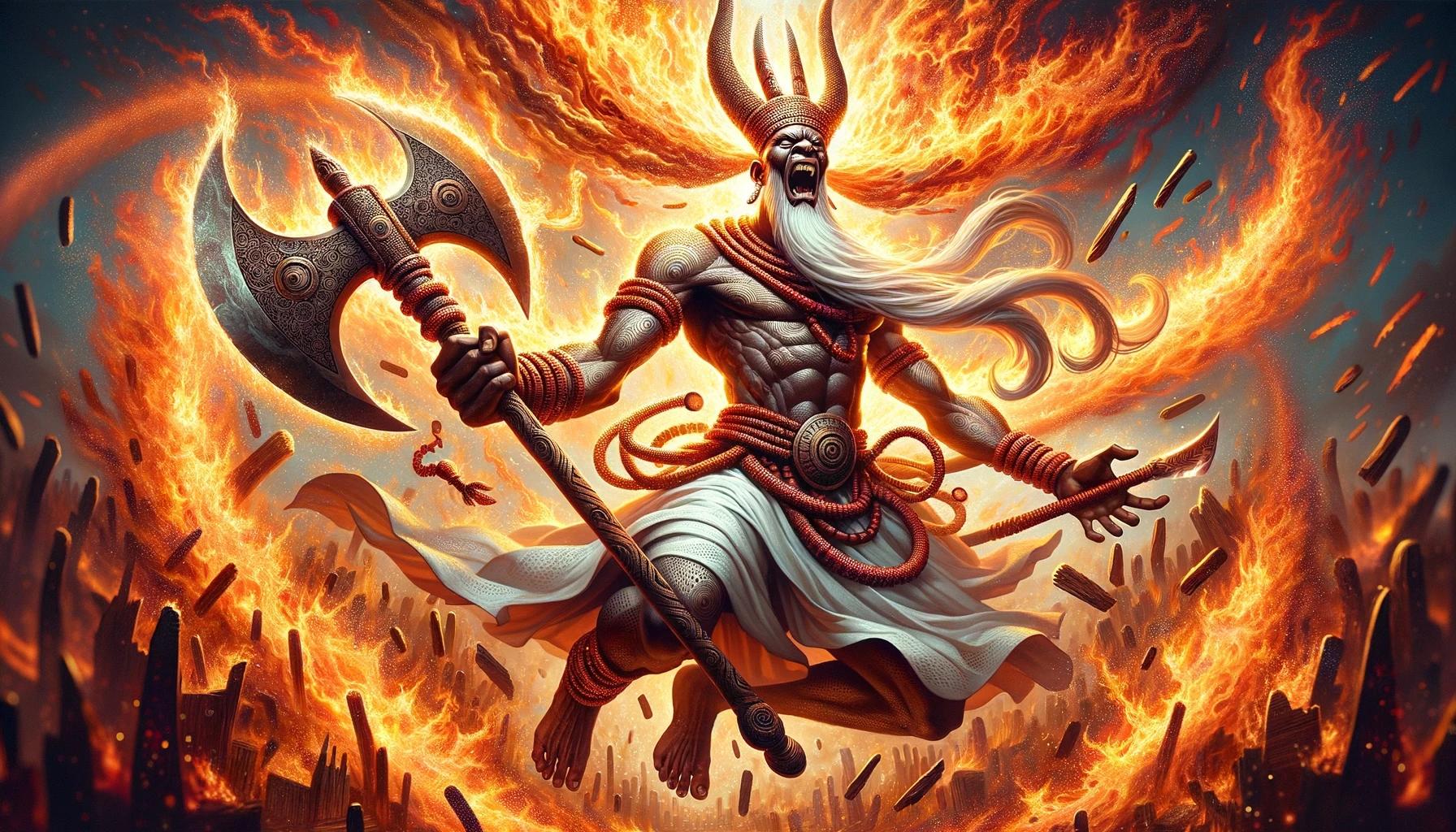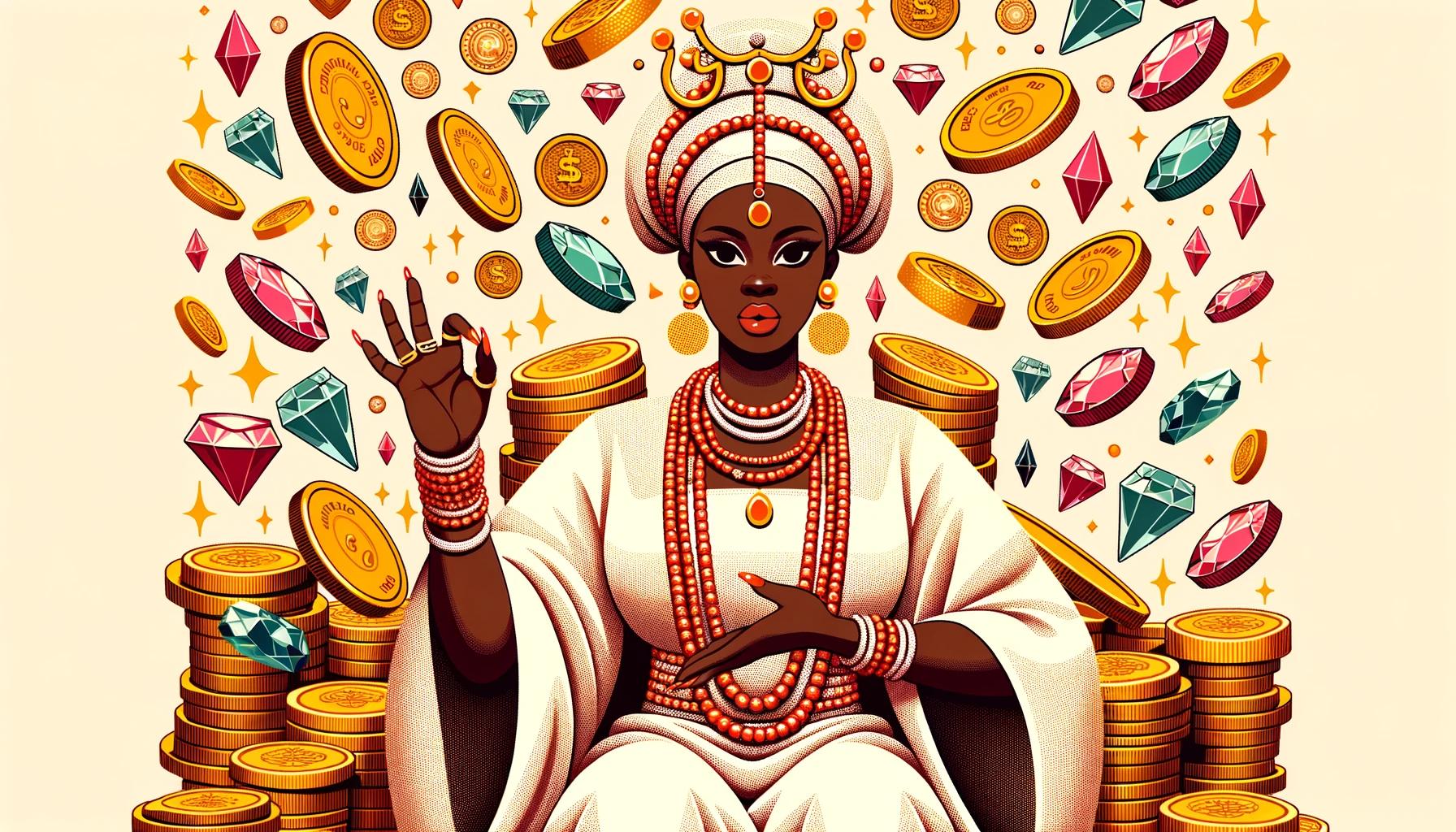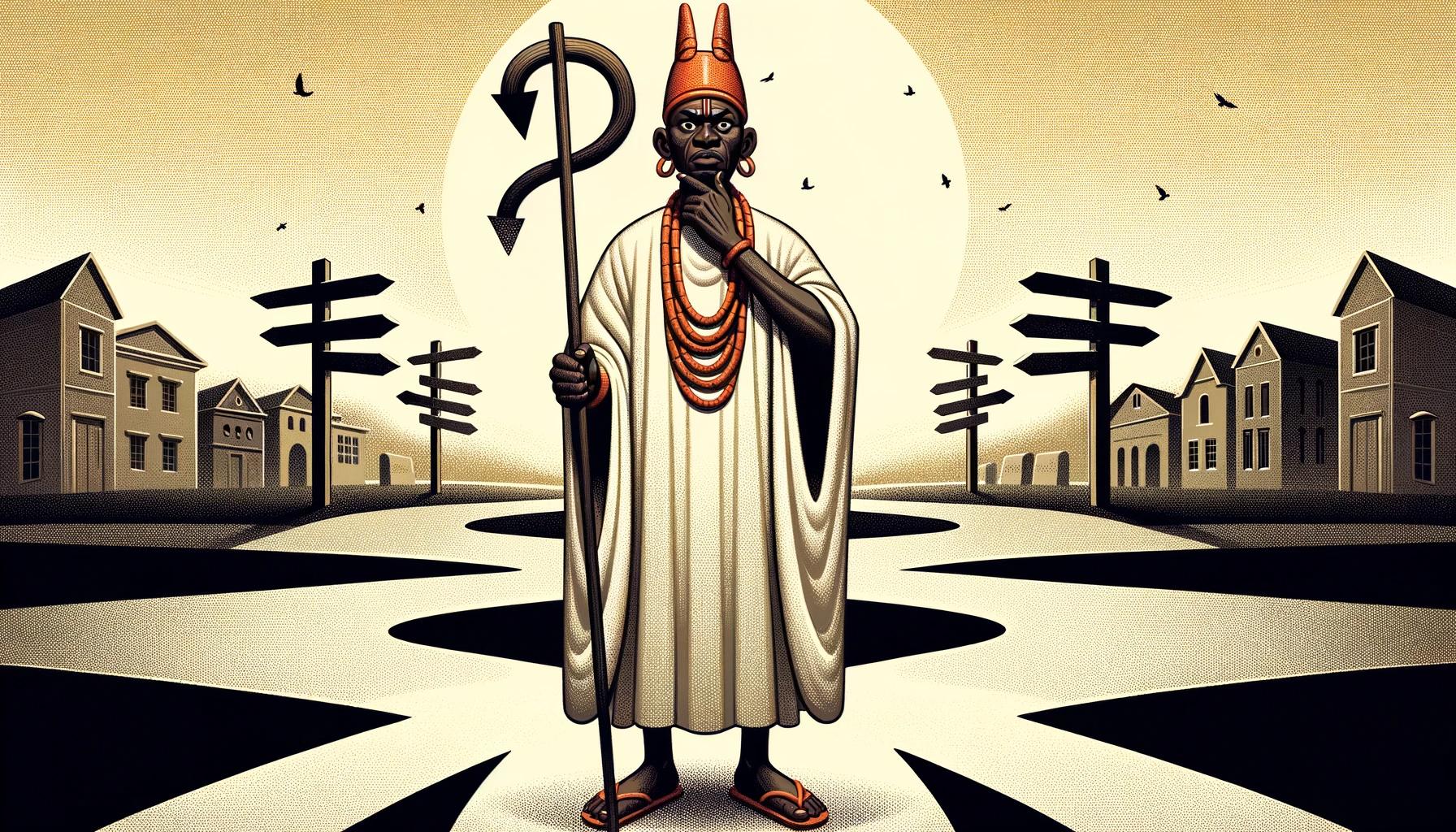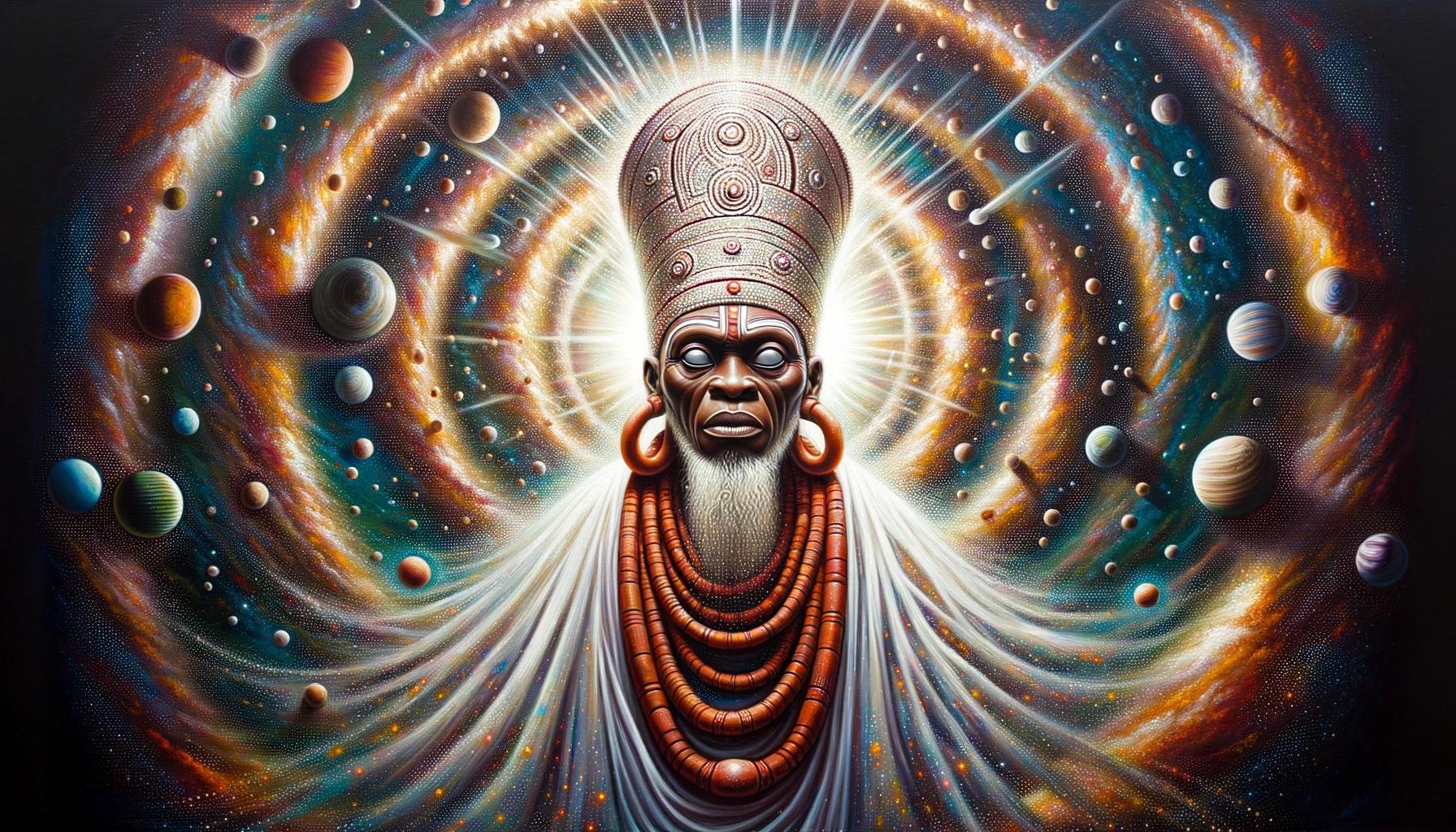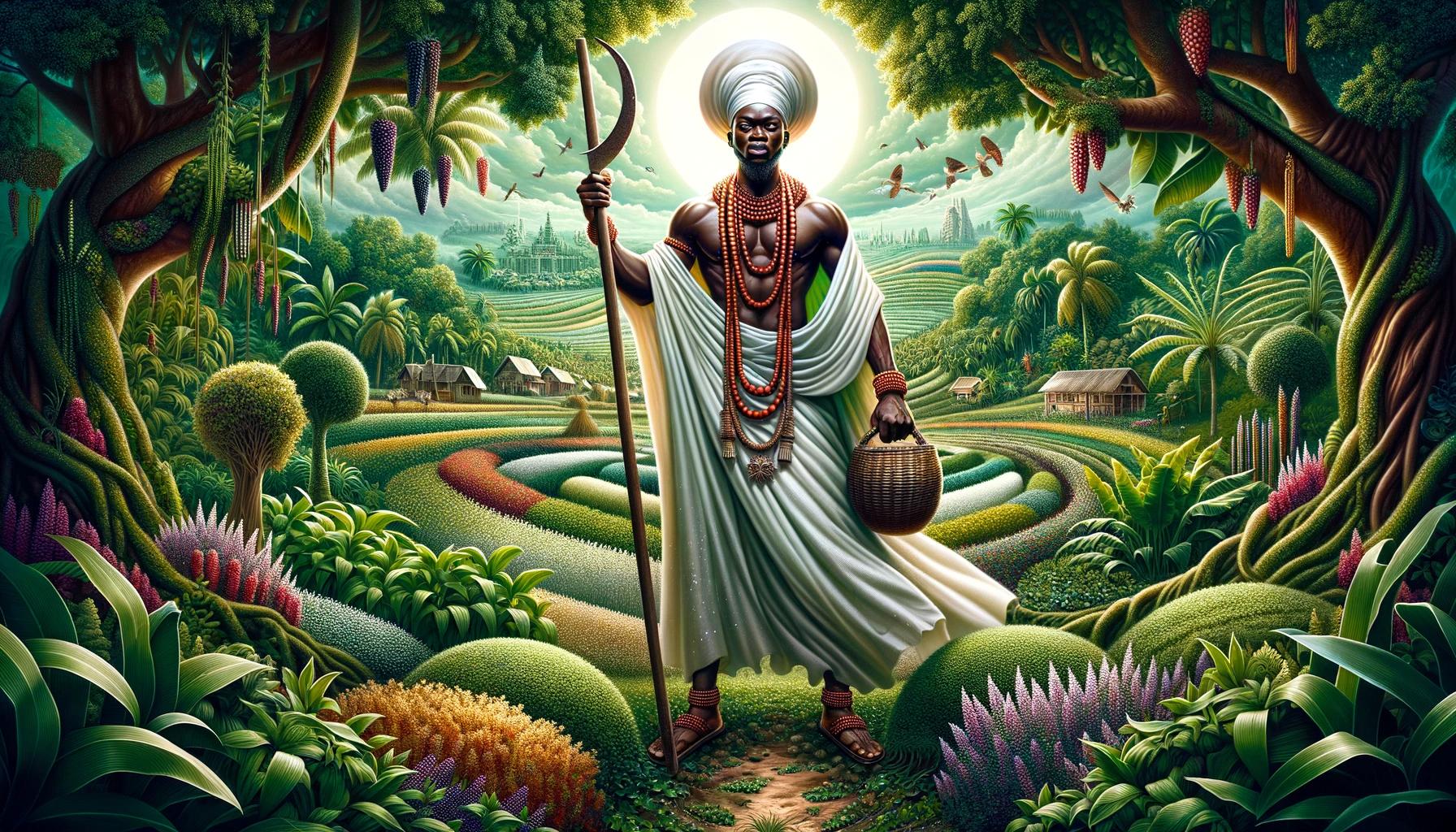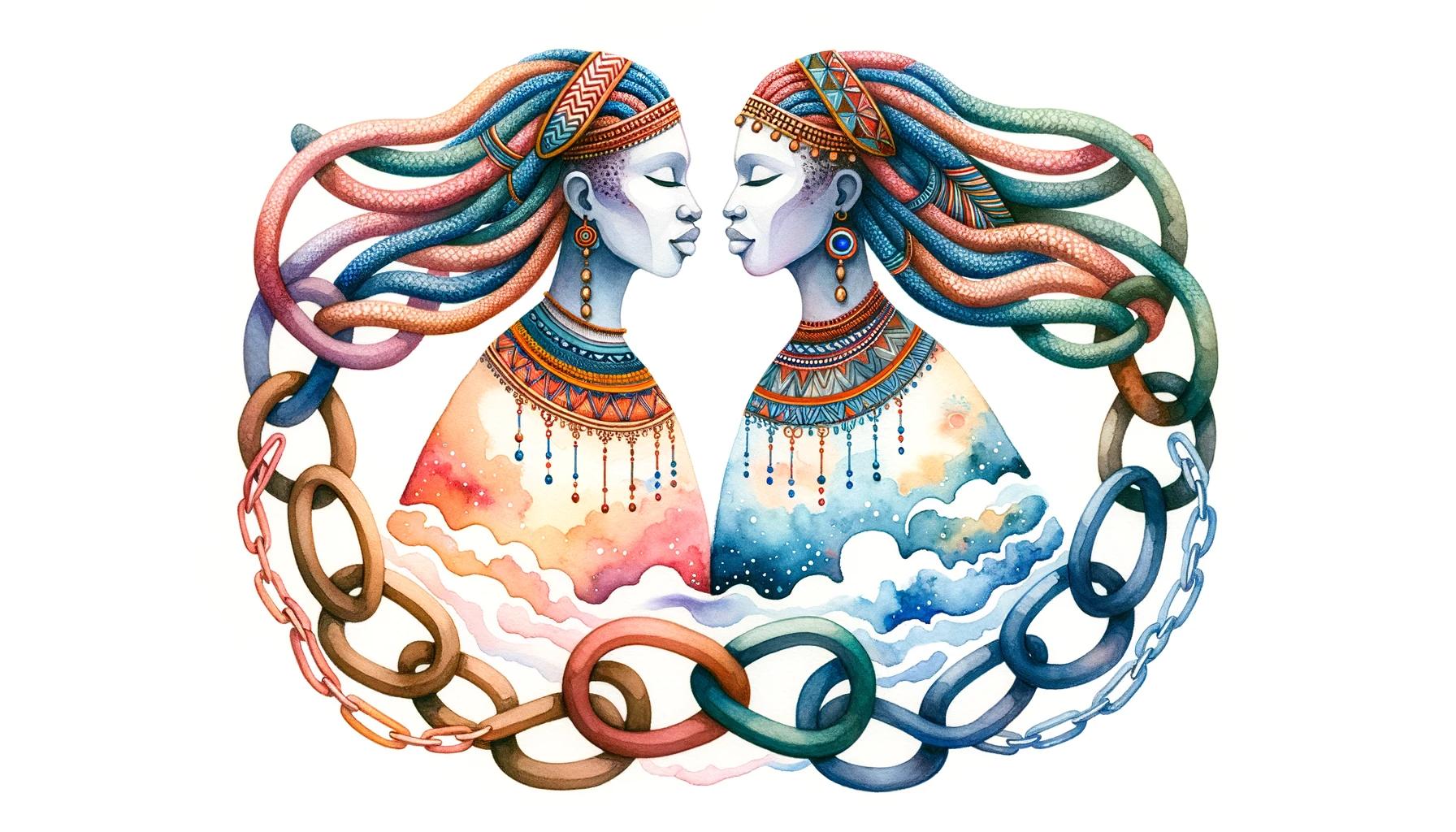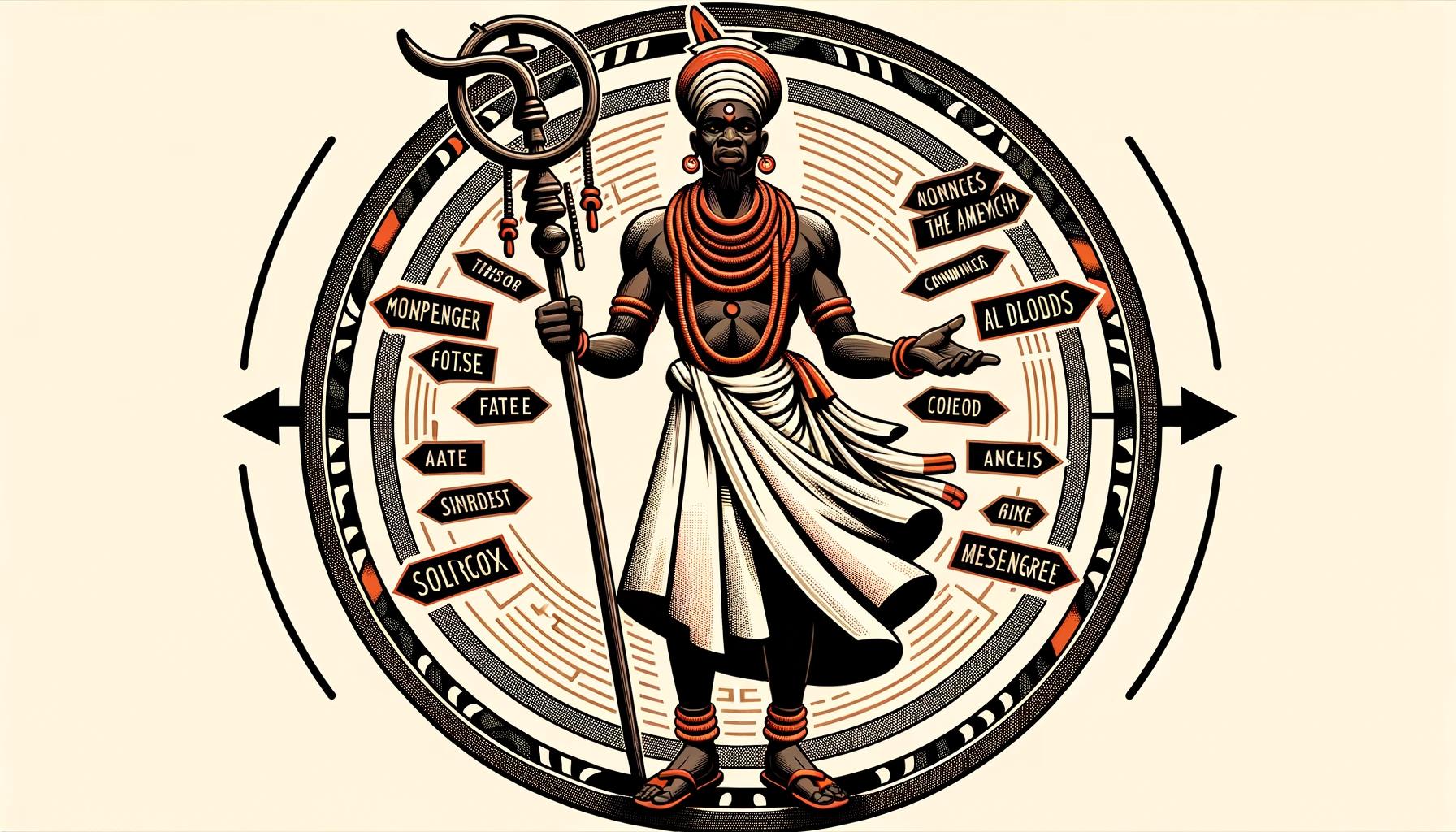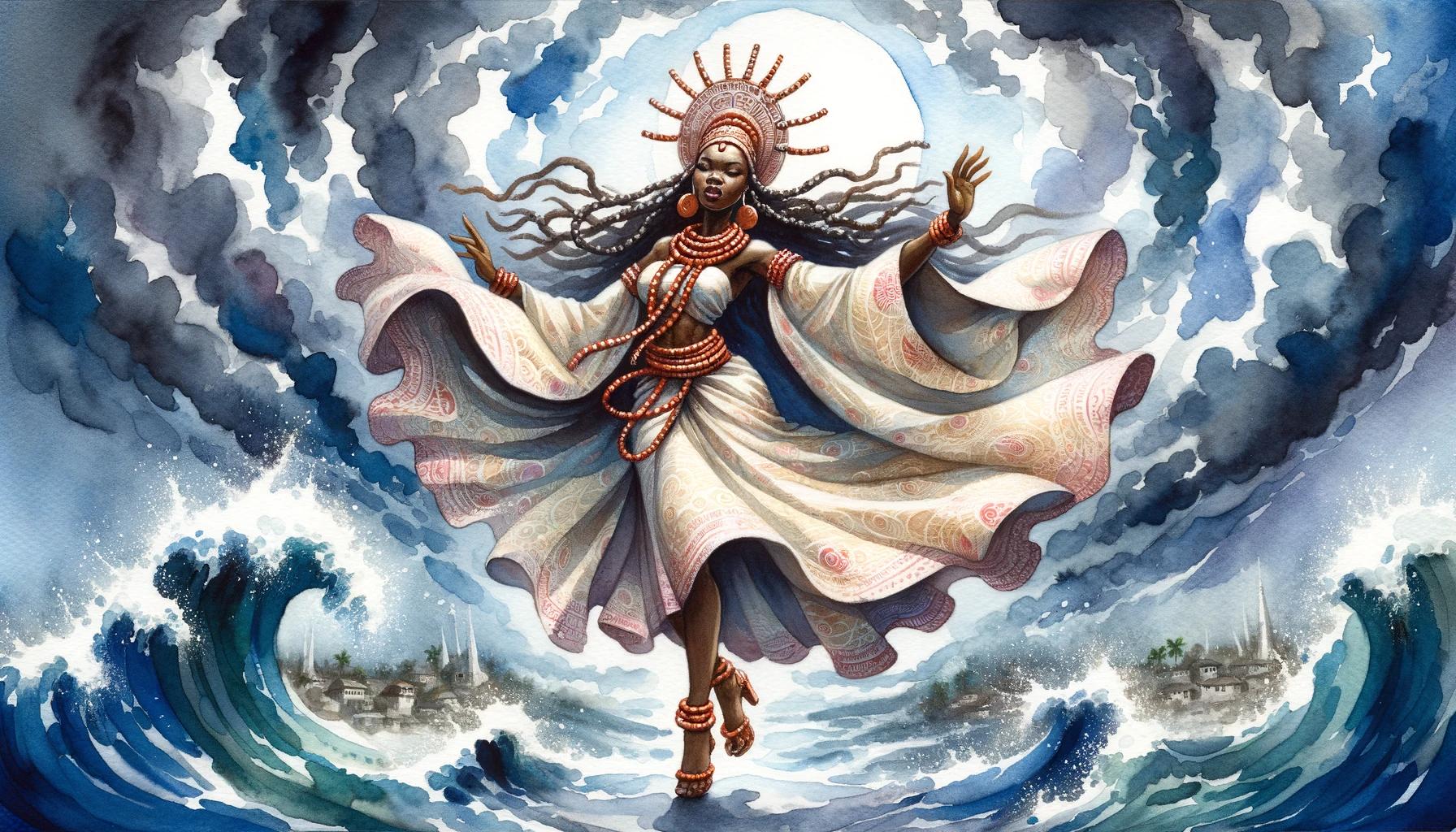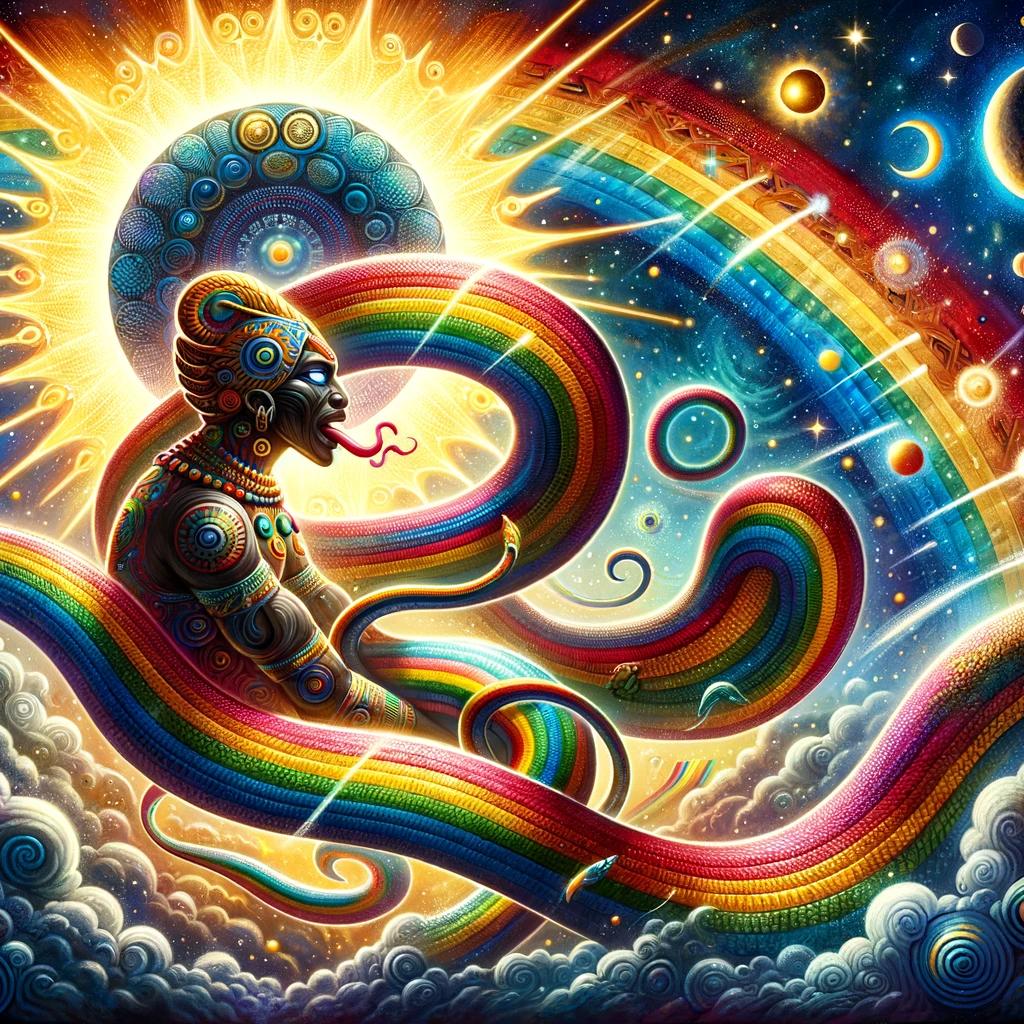Who is Sango the God of Thunder: Unveiling the Powerful Yoruba Deity
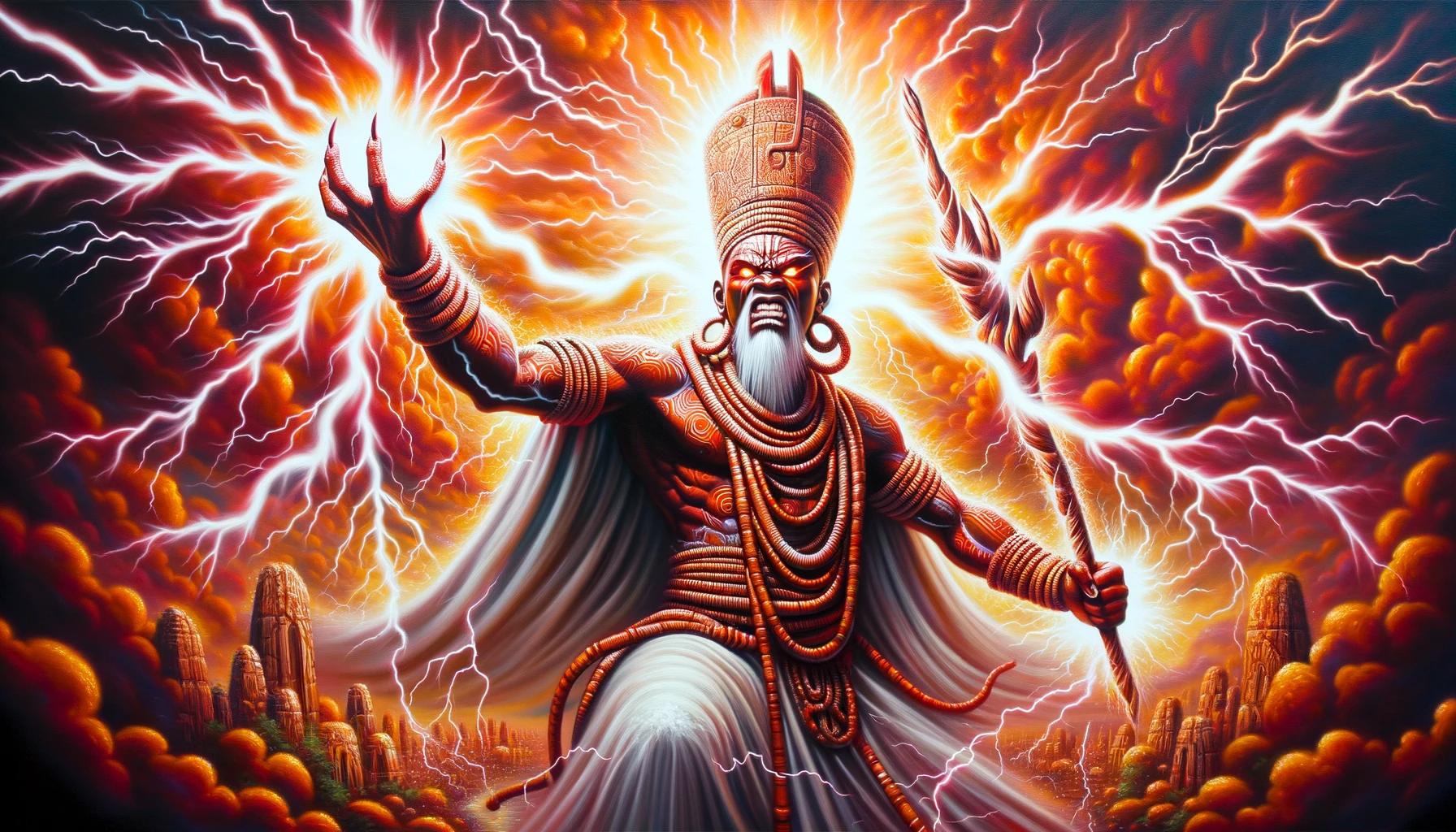
Sango, the god of thunder and lightning, is a revered deity in Yoruba mythology. As the third king of the Kingdom of Oyo, Sango holds great significance both as a historical figure and a divine entity.
Known for his symbol of a double-headed axe representing swift and balanced justice, Sango’s reign was marked by challenges, powerful generals, and a tragic departure. His worship extends beyond Nigeria and finds syncretism in various Afro-American traditions.
This article explores the origins, reign, influence, and representation of Sango the god of thunder.
The Origin and Mythology of Sango
Sango, the powerful god of thunder and lightning, has a rich origin and mythology within the Yoruba culture. According to Yoruba mythology, Sango is believed to have emerged from the body of the goddess Yemaja, along with 14 other Orishas, after her son attempted to violate her.
This origin story symbolizes Sango’s connection to divine justice and balance, as represented by his double-headed axe, a powerful emblem of swift and fair judgment.
Another version of Sango’s origin suggests that he is the son of Aganju and Obatala. In this narrative, Sango had to prove his lineage by plunging into a lake of fire, where he was able to reunite with Aganju. This enraptured journey not only establishes Sango’s ancestral roots but also showcases his resilience and determination.
Sango’s mythology is intertwined with his historical significance as the third king of the Kingdom of Oyo. His reign was marked by various struggles and triumphs, making him a widely respected figure.
Throughout his rule, Sango faced numerous threats, particularly from Olowu, the ruler of the Owu Kingdom.
His journey as a king was filled with challenges posed by powerful generals like Timi Agbale Olofa-ina and Gbonka.
Sango carefully navigated these political dynamics and received guidance from the wise Oya, who helped him exile Timi to a border city. While Gbonka initially posed a threat, Sango, in his pursuit of justice, ordered his execution by burning.
However, Gbonka surprisingly reappeared after three days, issuing a menacing ultimatum that prompted Sango to contemplate relinquishing his throne.
This pivotal moment led Sango to display his formidable power. Positioning himself atop a towering rock, he unleashed a thunderous bolt that struck and engulfed the palace in flames.
Filled with grief and desolation, Sango temporarily left the city, but the fervent appeals of his devoted followers convinced him to return.
While some chiefs also responded to his call, a rumor spread that Sango had taken his own life.
Contrary to this falsehood, he had actually vanished into thin air after he was ambushed by Gbonka, just moments before their fateful encounter.
Sango’s mythology and origin reflect the intricate tapestry of Yoruba culture, unveiling his divine lineage, his rise to power, and the mystique that surrounds his persona as the god of thunder.
As we delve deeper into Sango’s life, we will explore his reign, his extraordinary powers, and his enduring influence not only within Nigeria but also across various Afro-American traditions.
Sango as a Historical Figure
Sango, the god of thunder and lightning, holds a prominent place in Yoruba history as a significant figure.
He is believed to have been a real ancestor of the Yoruba people and served as the third king of the mighty Oyo Empire. Legend has it that Sango emerged from the body of the goddess Yemaja along with 14 other Orishas, after her son’s attempted violation.
However, another version of the story suggests that Sango is the son of Aganju and Obatala, and he had to prove his lineage by plunging into a lake of fire to reunite with Aganju.
During his reign, the Kingdom of Oyo faced numerous challenges, particularly from Olowu, the ruler of the Owu Kingdom.
Sango’s remarkable leadership came to the forefront when he rescued King Ajaka from Owu’s clutches, leading to his own coronation as the king. However, his reign was not without internal struggles, as he had to confront two powerful generals, Timi Agbale Olofa-ina and Gbonka.
Seeking guidance from Oya, Sango banished Timi to govern a border town, effectively removing him as a threat. Nevertheless, Gbonka posed an even greater danger, prompting Sango to order Gbonka to capture Timi.
Unexpectedly, Gbonka emerged victorious over Timi but, rather than fulfilling Sango’s command to execute him, Sango ordered Gbonka himself to be burned alive. In a mysterious turn of events, Gbonka reappeared unharmed after three days and menaced Sango, forcing him to flee his throne.
In a fit of anger and despair, Sango sought solace on a high rock facing the palace, displaying the might of his thunderous power. The lightning he unleashed that day struck and consumed the palace in flames.
Heartbroken and burdened, Sango left the city, but his followers persuaded him to return. Rumors spread that Sango had taken his own life, while, in reality, he vanished into thin air after being attacked by Gbonka, never facing him directly.
Sango has remained an influential and feared deity in Nigeria, lauded as one of the most omnipotent figures in Yoruba mythology. He is renowned for casting thunderstones that create thunder and lightning to punish those who offend him.
His worship extends beyond the shores of Nigeria, as his syncretic presence can be found in the New World, where he blends with figures such as Santa Bárbara or San Jerónimo.
In the Americas, he is venerated as ‘Changó’ in Santería and ‘Xangô’ in Candomblé.
Sango’s legacy and depiction in various Afro-American religious traditions, including Vodou in Haiti and Palo, showcase the enduring impact of his divinity.
He is represented in a wide range of religious statues, animal figures, pedestals, and columns, typically depicted with a double-headed axe and a brass crown.
In conclusion, Sango stands as both a historical figure and a potent god of thunder and lightning in Yoruba mythology.
His reign, struggles, and the symbolism surrounding his powers contribute to his significant influence in Nigeria and beyond.
Sango’s Reign and Struggles
Sango’s reign as the king of the Kingdom of Oyo was marked by numerous challenges and struggles. One of the prominent threats he faced was from Olowu, the ruler of the neighboring Kingdom of Owu.
Olowu constantly posed a threat to the stability and power of Oyo, pressing Sango to take decisive action.
Being a resourceful and determined leader, Sango embarked on a mission to rescue King Ajaka of Owu, who had been captured by Olowu.
Sango’s successful rescue of Ajaka earned him the right to be crowned as the new king of Oyo. However, this victory did not come without consequences.
During his reign, Sango encountered two powerful generals, Timi Agbale Olofa-ina and Gbonka, who posed a significant challenge.
By following the wise counsel of Oya, one of his divine advisors, Sango exiled Timi to govern a border town, hoping to mitigate the threat he posed to the kingdom.
Unfortunately, Gbonka proved to be an even greater threat to Sango’s rule. The king ordered Gbonka to capture and defeat Timi, but instead of eliminating him as instructed, Gbonka spared Timi’s life.
Incensed by Gbonka’s defiance, Sango demanded his execution by burning. Yet, to everyone’s surprise, Gbonka miraculously reappeared after three days, issuing a grave warning to Sango and demanding his abdication from the throne.
Overwhelmed by anger and sorrow, Sango abandoned the palace and situated himself atop a high rock, displaying the sheer force of his thunderbolts. On that fateful day, his thunderous strike not only hit but also engulfed and burned down the palace, leaving Sango devastated.
While grief-stricken, the people managed to convince him to return to the kingdom.
Some chiefs and followers remained loyal, but rumors spread that Sango had taken his own life by hanging.
In truth, it was Gbonka who had ambushed Sango, causing him to vanish into thin air before the confrontation could occur.
Despite the tumultuous end to his reign, Sango’s legacy as a formidable and revered ruler persists in Yoruba mythology and beyond.
His struggles against external threats and internal dissension have become a testament to his strength and determination as the god of thunder.
Sango’s Powers and Symbolism
Sango, the powerful god of thunder and lightning, embodies a range of remarkable powers and holds great significance in Yoruba mythology. As the deity associated with these natural phenomena, Sango possesses the ability to control and manipulate thunderstorms.
His thunderous roar resonates through the heavens, echoing his dominance over the skies.
One of Sango’s most notable powers is his capacity to conjure lightning bolts at will. With a mere wave of his hand, he can unleash these electrifying forces, illuminating the darkness and striking awe into the hearts of mortals.
The thunder and lightning are not only a display of his immense power but also serve as a symbol of his presence, signaling his divine influence.
Sango’s symbolism is rich and multifaceted.
His symbol, the double-headed axe, represents both swift justice and balanced judgment. This symbolizes the importance of fairness and prompt action in the face of wrongdoing. Sango’s harnessed power embodies the notion of swift retribution, ensuring that justice is delivered swiftly and appropriately.
Besides his role as the god of thunder, Sango is also associated with other symbolic elements. The color red, often depicting fire and passion, is closely linked to his persona. It represents his fiery temperament, his unpredictable nature, and his connection to the destructive power of lightning.
Additionally, the thunder and lightning associated with Sango symbolize the unpredictability of life, reminding us of the forces beyond our control.
Symbolizing strength and authority, Sango is often depicted wearing a crown of brass on his head.
This regal adornment further signifies his status as a deity and a royal figure. The crown serves as a visual representation of his power and suggests his divine right to rule over the natural elements he commands.
Overall, Sango’s powers and symbolism are a testament to his awe-inspiring nature. As the god of thunder and lightning, he possesses the ability to invoke fear and respect, commanding the forces of nature with unparalleled might.
His symbols and attributes further enhance his persona, portraying him as a just and powerful deity of remarkable influence.
Sango’s Influence and Worship in Nigeria
Sango, the god of thunder and lightning, holds immense influence in Nigerian culture and religion. He is revered as one of the most powerful deities and is worshipped by many communities throughout the country.
Sango’s worship is deeply rooted in the Yoruba tradition, where he is considered a divine force of nature.
Devotees of Sango believe in his ability to control thunderbolts, storms, and all forms of natural phenomena associated with thunder and lightning.
They see him as a protector and a source of justice, often turning to him for guidance and assistance in times of need. Sango’s reputation as a fearsome deity has made him an integral part of Nigerian religious practices.
Worship of Sango involves various rituals and ceremonies that seek to honor and appease him. These rituals typically consist of offering sacrifices such as animals, fruits, and other symbolic items. His followers also engage in drumming, dancing, and chanting as a means to invoke his presence and establish a spiritual connection with him.
The worship of Sango is not limited to specific geographic areas in Nigeria. His influence can be felt across different regions, tribes, and social classes. From rural villages to urban centers, Sango’s presence is evident in the hearts and minds of his devoted followers.
It is worth noting that Sango’s cult is not exclusive to Nigeria. Through the diaspora, his worship has spread to different parts of the world, particularly in Afro-diasporic religions such as Santería and Candomblé.
In these syncretic traditions, Sango has been assimilated with Catholic saints, resulting in unique forms of worship that blend African and European religious practices.
Overall, Sango’s influence and worship in Nigeria remain strong and deeply ingrained in the cultural fabric of the country.
His power as the god of thunder continues to captivate and inspire both believers and those interested in the rich spiritual heritage of the Yoruba people.
Sango’s Syncretism in the New World
Sango’s influence expanded beyond Nigeria and reached the shores of the New World, where his worship blended with Afro-American traditions.
In these syncretic religions, Sango is known by different names such as Changó in Santería and Xangô in Candomblé. This fusion of beliefs and practices created a unique spiritual expression that continues to thrive today.
In Santería, Sango is associated with Santa Bárbara or San Jerónimo, combining elements of Yoruba spirituality with Catholicism. The syncretism represents the adaptation of traditional African deities into the religious framework imposed by colonial powers.
Sango’s characteristics and attributes align with those of Santa Bárbara, creating a seamless blending of cultural and religious practices.
- Sango, known as Changó in Santería, is revered as the god of fire, thunder, and justice.
- His double-headed axe symbolizes swift and balanced justice, similar to the sword of Santa Bárbara.
- Red and white, the colors associated with both Sango and Santa Bárbara, further solidify their connection.
Similarly, in Candomblé, Sango is worshipped as Xangô, a powerful deity associated with thunder, fire, and male virility.
Candomblé, originating in Brazil, incorporates elements from Yoruba religion, indigenous beliefs, and Catholicism.
Xangô, portrayed with attributes like a double-edged axe, exemplifies strength, authority, and justice. His fiery personality and thunderous presence align with Sango’s characteristics, showcasing the shared cultural and spiritual roots.
Both Santería and Candomblé embrace the syncretism of Sango, highlighting the resilience and adaptability of African spiritual traditions in the face of colonization. The fusion of Yoruba gods with Catholic saints in Santería and the incorporation of indigenous elements in Candomblé demonstrate the rich tapestry of Afro-American religious practices.
Sango in Afro-American Traditions
Sango’s influence and worship extended beyond Nigeria and found its way into Afro-American traditions, particularly in the Americas. Through the transatlantic slave trade, the Yoruba religious practices and deities, including Sango, were transported to the New World, where they experienced syncretism with Catholicism and other African traditional religions.
In Haitian Vodou, Sango is widely recognized and revered under the name “Changó.” He is often associated with thunder, justice, and fire. In Vodou ceremonies, Sango is invoked for his immense power and protection, and his symbolic representations, such as double-headed axes, drums, and lightning bolts, play significant roles in rituals and offerings.
Sango’s presence is also felt in the Afro-Caribbean religion known as Santería. Here, Sango is syncretized with Catholic saints, particularly Saint Barbara and San Jerónimo. He is venerated for his strength, fierceness, and ability to control lightning and thunder.
In Santería, Sango is called upon for justice, protection, and guidance in times of difficulty.
In the Afro-Brazilian religion Candomblé, Sango is known as “Xangô.” He is considered one of the most powerful orixás, representing masculinity, passion, and justice.
Xangô is associated with thunder, fire, and rock formations. His followers seek his influence and guidance for matters of justice, leadership, and personal strength.
The syncretism of Sango in these Afro-American traditions showcases the adaptability and resilience of Yoruba religious beliefs and the enduring influence of this powerful god of thunder and lightning.
Representation and Iconography of Sango
Sango, the powerful god of thunder, is often depicted in various forms of representation and iconography. These visual representations play a significant role in showcasing Sango’s attributes and symbolism. Here are some common depictions and symbols associated with Sango:
- Hacha de doble cabeza (Double-Headed Axe): One of the most prominent symbols of Sango is the double-headed axe, which represents quick and balanced justice.
This symbol is often incorporated in statues, artwork, and ceremonial objects associated with Sango.
- Ropa roja (Red Attire): Sango is often depicted wearing red garments, symbolizing his association with fire, passion, and power.
The vibrant red color reflects his fiery nature and the energy he possesses.
- Xabáns (Thunderstones): Another crucial element in Sango’s representation is the thunderstones, called “xabáns” in Yoruba. These stones are believed to be sent by Sango as a display of his thunderous power, creating lightning and thunder when they strike the ground.
In art, these thunderstones are sometimes depicted as round stones held by Sango or incorporated into his attire.
- Corona de latón (Brass Crown): Sango is often shown wearing a regal brass crown, symbolizing his royal status as the former ruler of the Kingdom of Oyo.
The detailed design of the crown reflects his authority and divine lineage.
- Rayos (Lightning Bolts): Lightning bolts are a primary representation of Sango’s power over thunder and lightning. Sometimes these bolts are depicted emanating from his body or as separate elements surrounding him, emphasizing his commanding presence.
Artists and craftsmen have created a diverse range of statues, sculptures, and artwork portraying Sango and his symbolic representations.
These artistic creations serve as reminders of his divine essence and are revered by his followers and worshippers.
Sango’s representation and iconography have also extended beyond physical art forms to cultural expressions such as music, literature, and dance.
His influence can be seen in songs, poems, and traditional performances that pay tribute to his majestic presence and divine powers.
In conclusion, the representation and iconography of Sango showcase the varied symbols associated with this mighty Yoruba god of thunder.
Through double-headed axes, red attire, thunderstones, brass crowns, and lightning bolts, Sango’s visual depictions capture his power, authority, and divine nature.
FAQs about Sango the God of Thunder
Curious to learn more about Sango, the powerful god of thunder? Here, we address some commonly asked questions about Sango and his significance in Yoruba mythology:
Q: What role does Sango play in Yoruba mythology?
A: Sango is regarded as the god of thunder and lightning in Yoruba mythology.
He holds immense power over the elements and is known for wielding his double-headed axe, representing swift and fair justice.
Q: How did Sango come into existence?
A: According to one version of the myth, Sango emerged along with 14 other Orishas from the body of the goddess Yemaja.
Another version suggests that Sango is the son of Aganju and Obatala. He proved his lineage by jumping into a lake of fire as a test.
Q: What challenges did Sango face during his reign?
A: Sango’s reign as the ruler of the Kingdom of Oyo was marked by constant threats from Olowu, the king of Owu.
He was compelled to confront powerful generals like Timi Agbale Olofa-ina and Gbonka, who posed significant challenges to his leadership.
Q: What are Sango’s powers and symbolism?
A: Sango possesses the ability to produce thunderstorms and lightning, displaying his dominion over the forces of nature.
His symbol, the double-headed axe, represents his quick and balanced dispensation of justice.
Q: How is Sango worshiped in Nigeria?
A: Sango is revered as one of the most formidable and venerated deities in Nigeria.
His devotees offer prayers, sacrifices, and perform rituals to honor his power and seek his protection and blessings.
Q: How is Sango syncretized in the New World?
A: Sango’s worship transcended Nigerian borders and fused with different Afro-American traditions.
In Santería, he is known as ‘Changó,’ while in Candomblé, he is referred to as ‘Xangô.’
Q: In which Afro-American traditions is Sango prominent?
A: Sango’s influence extends to various Afro-American traditions, including Vodou in Haiti and Palo.
He is revered and invoked for his power, protection, and justice.
Q: How is Sango represented visually?
A: Sango is often depicted with his double-headed axe and a brass crown, symbolizing his authority and strength.
Statues and sculptures portraying him can be found, along with various religious artifacts associated with his cult.
Q: Are there any popular references to Sango in literature and music?
A: Sango’s name finds mention in popular songs and literary works, highlighting his significance and continued influence across cultures and artistic expressions.
These frequently asked questions provide a glimpse into the intriguing figure of Sango and his role as the god of thunder in Yoruba mythology. Exploring his mythology, worship, and representation sheds light on the enduring power and fascination surrounding this ancient deity.











